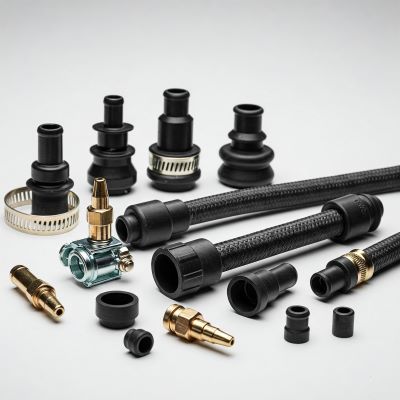Vacuum systems play a vital role in modern automobiles, controlling various functions such as:
➡️ Engine Control: Regulating air-fuel mixture, controlling idle speed, and operating emissions systems.
➡️ Power Brakes: Assisting in brake pedal effort for improved braking performance.
➡️ Climate Control: Operating HVAC systems, including heating and air conditioning.
➡️ Other Systems: Controlling cruise control, power steering, and even some suspension systems.
What Are Automotive Vacuum Hose Fittings?
Vacuum hose fittings are specialized connectors that join vacuum hoses together or connect hoses to other components in the vacuum system. They come in various shapes and sizes to accommodate different hose diameters and system configurations.
How Vacuum Hose Fittings Contribute to Engine Efficiency
By ensuring a secure and leak-free connection, vacuum hose fittings:
➡️ Maintain Proper Vacuum Levels: Allowing the engine control systems to function optimally.
➡️ Improve Fuel Economy: By preventing air leaks into the intake manifold, which can disrupt the air-fuel mixture.
➡️ Enhance Brake Performance: Ensuring consistent and reliable brake assist for improved stopping power.
➡️ Optimize Climate Control: Enabling efficient operation of HVAC systems for passenger comfort.
Why Proper Vacuum Hose Fittings Are Crucial for Vehicle Performance
Vacuum hose fittings are the critical connection points within the vacuum system. Improper fittings can lead to:
➡️ Vacuum Leaks: Compromising system function and leading to engine performance issues, sluggish brakes, and erratic climate control.
➡️ Reduced Fuel Efficiency: Vacuum leaks can disrupt the air-fuel mixture, resulting in increased fuel consumption.
➡️ Check Engine Light: Vacuum leaks can trigger the check engine light, indicating a malfunction in the engine control system.
➡️ Safety Hazards: In severe cases, vacuum leaks can affect brake performance, posing a serious safety risk.
Types of Automotive Vacuum Hose Fittings
Straight Fittings Versus Elbow Fittings When to Use Each
➡️ Straight Fittings: Used for connecting hoses in a straight line.
➡️ Elbow Fittings: Used to change the direction of the vacuum line, allowing for flexible routing and installation.
Quick-Connect Fittings for Convenience and Speed
➡️ Quick-connect fittings enable quick and easy connection and disconnection of hoses, facilitating maintenance and repairs.
Barbed Fittings for Secure Hose Connections
➡️ Barbed fittings feature small protrusions that grip the hose securely, preventing slippage and leaks.
Specialized Fittings for Unique Automotive Applications
➡️ Some specialized fittings are designed for specific applications, such as those used in brake booster lines or emissions control systems.
Materials Used in Vacuum Hose Fittings
Plastic Fittings Lightweight and Cost-Effective Solutions
➡️ Plastic fittings are inexpensive, lightweight, and corrosion-resistant.
Metal Fittings Strength and Durability for High-Stress Systems
➡️ Metal fittings offer superior strength and durability, making them suitable for high-pressure and high-temperature applications.
Composite Materials Balancing Strength and Flexibility
➡️ Composite materials combine the strength of metal with the flexibility of plastic, offering a balance of properties.
Selecting the Right Vacuum Hose Fittings for Your Vehicle
Understanding Hose and Fitting Compatibility
➡️ Ensure the inner diameter of the hose matches the fitting’s bore size for a secure and leak-free connection.
Key Factors to Consider Pressure, Temperature, and Fluid Type
➡️ Choose fittings that can withstand the pressure and temperature conditions within the vacuum system.
➡️ Consider the type of fluid that will be flowing through the system when selecting materials for the fittings.
Tips for Measuring and Ensuring a Perfect Fit
➡️ Accurately measure the hose diameter before purchasing fittings.
➡️ Use a hose clamp to secure the hose to the fitting for a tight and reliable connection.
Installation and Maintenance of Vacuum Hose Fittings
Step-by-Step Guide to Installing Vacuum Hose Fittings
1. Clean the Hose: Remove any dirt or debris from the hose end before inserting it into the fitting.
2. Insert the Hose: Carefully insert the hose into the fitting, ensuring it is fully seated.
3. Secure with a Clamp: Use a hose clamp to secure the hose to the fitting, tightening it evenly to prevent leaks.
4. Inspect for Leaks: After installation, inspect the connections for any signs of leaks.
Common Installation Mistakes to Avoid
➡️ Using the wrong size fittings.
➡️ Overtightening hose clamps, which can damage the hose.
➡️ Failing to clean the hose before installation.
Routine Maintenance for Longevity and Performance
➡️ Regularly inspect hose fittings for signs of wear and tear, such as cracks, leaks, or loose connections.
➡️ Replace any damaged or worn-out fittings promptly.
➡️ Clean the fittings periodically to remove dirt and debris.
Troubleshooting Vacuum Hose Fitting Issues
Identifying Signs of Leaks and Weak Connections
➡️ Engine Performance Issues: Rough idling, hesitation, or stalling.
➡️ Reduced Brake Assist: Increased brake pedal effort.
➡️ Climate Control Problems: Inconsistent heating or cooling.
➡️ Check Engine Light: Illuminated due to vacuum leaks affecting engine control systems.
➡️ Hissing Sounds: Audible hissing sounds from under the hood may indicate a vacuum leak.
How to Address Loose or Damaged Fittings
➡️ Tighten Loose Fittings: Carefully tighten loose hose clamps, but avoid overtightening.
➡️ Replace Damaged Fittings: Replace any damaged or cracked fittings with new ones.
When to Replace Versus Repair Vacuum Hose Fittings
➡️ Minor Issues: Loose fittings can often be tightened.
➡️ Significant Damage: Cracked or broken fittings should be replaced.
Conclusion
This guide provides you with the knowledge and tools to understand and maintain your vehicle’s vacuum hose fittings effectively. By making informed choices and performing regular maintenance, you can optimize your vehicle’s performance and ensure its long-term reliability.
Here are some tips you should remember:
➡️ Select the right type of fittings for your specific application, considering factors such as hose diameter, pressure, and temperature.
➡️ To stop leaks, make sure everything is installed correctly and that the connections are secure.
➡️ Regularly inspect and maintain fittings to ensure optimal system performance.
➡️ Address any issues promptly to prevent further damage and maintain vehicle safety and efficiency.
Post time: Jan-22-2025


